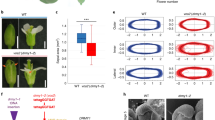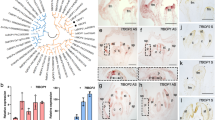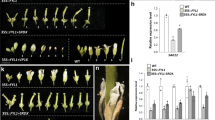Abstract
Abnormal flowers have been recognized for thousands of years, but only in the past decade have the mysteries of flower development begun to unfold. Among these mysteries is the differentiation of four distinct organ types (sepals, petals, stamens and carpels), each of which may be a modified leaf1. A landmark accomplishment in plant developmental biology is the ABC model of flower organ identity2,3. This simple model provides a conceptual framework for explaining how the individual and combined activities of the ABC genes produce the four organ types of the typical eudicot flower. Here we show that the activities of the B and C organ-identity genes require the activities of three closely related and functionally redundant MADS-box genes, SEPALLATA1/2/3 (SEP1/2/3). Triple mutant Arabidopsis plants lacking the activity of all three SEP genes produce flowers in which all organs develop as sepals. Thus SEP1/2/3 are a class of organ-identity genes that is required for development of petals, stamens and carpels.
This is a preview of subscription content, access via your institution
Access options
Subscribe to this journal
Receive 51 print issues and online access
$199.00 per year
only $3.90 per issue
Buy this article
- Purchase on Springer Link
- Instant access to full article PDF
Prices may be subject to local taxes which are calculated during checkout



Similar content being viewed by others
References
Meyerowitz, E. M., Smyth, D. R. & Bowman, J. L. Abnormal flowers and pattern formation in floral development. Development 106, 209–217 (1989).
Coen, E. S. & Meyerowitz, E. M. The war of the whorls: genetic interactions controlling flower development. Nature 353, 31–37 (1991).
Bowman, J. L., Smyth, D. R. & Meyerowitz, E. M. Genetic interactions among floral homeotic genes of Arabidopsis. Development 112, 1–20 (1991).
Schwarz-Sommer, Z., Huijser, P., Nacken, W., Saedler, H. & Sommer, H. Genetic control of flower development: homeotic genes in Antirrhinum majus. Science 250, 931–936 (1990).
Drews, G. N., Bowman, J. L. & Meyerowitz, E. M. Negative regulation of the Arabidopsis homeotic gene AGAMOUS by the APETALA2 product. Cell 65, 991–1002 (1991).
Irish, V. F. & Sussex, I. M. Function of the APETALA-1 gene during Arabidopsis floral development. Plant Cell 2, 741–751 (1990).
Mandel, M. A., Gustafson-Brown, C., Savidge, B. & Yanofsky, M. F. Molecular characterization of the Arabidopsis floral homeotic gene APETALA1. Nature 360, 273–277 (1992).
Jack, T., Brockman, L. L. & Meyerowitz, E. M. The homeotic gene APETALA3 of Arabidopsis thaliana encodes a MADS-box and is expressed in petals and stamens. Cell 68, 683–697 (1992).
Goto, K. & Meyerowitz, E. M. Function and regulation of the Arabidopsis floral homeotic gene PISTILLATA. Genes Dev. 8, 1548–1560 (1994).
Yanofsky, M. F. et al. The protein encoded by the Arabidopsis homeotic gene agamous resembles transcription factors. Nature 346, 35–39 (1990).
Jofuku, K. D., den Boer, B. G. W., Van Montagu, M. & Okamuro, J. K. Control of Arabidopsis flower and seed development by the homeotic gene APETALA2. Plant Cell 6, 1211–1225 (1994).
Kempin, S. A., Savidge, B. & Yanofsky, M. F. Molecular basis of the cauliflower phenotype in Arabidopsis. Science 267, 522–525 (1995).
Ferrándiz, C., Gu, Q., Martienssen, R. & Yanofsky, M. F. Redundant regulation of meristem identity and plant architecture by FRUITFULL, APETALA1 and CAULIFLOWER. Development 127, 725–734 (2000).
Liljegren, S. J. et al. SHATTERPROOF MADS-box genes control seed dispersal in Arabidopsis. Nature 404, 766–770 (2000).
Ma, H., Yanofsky, M. F. & Meyerowitz, E. M. AGL1-AGL6, an Arabidopsis gene family with similarity to floral homeotic and transcription factor genes. Genes Dev. 5, 484–495 (1991).
Mandel, M. A. & Yanofsky, M. F. The Arabidopsis AGL9 MADS-box gene is expressed in young flower primordia. Sex. Plant Reprod. 11, 22–28 (1998).
Flanagan, C. A. & Ma, H. Spatially and temporally regulated expression of the MADS-box gene AGL2 in wild-type and mutant Arabidopsis flowers. Plant Mol. Biol. 26, 581–595 (1994).
Savidge, B., Rounsley, S. D. & Yanofsky, M. F. Temporal relationship between the transcription of two Arabidopsis MADS box genes and the floral organ identity genes. Plant Cell 7, 721–733 (1995).
Tröbner, W. et al. GLOBOSA: a homeotic gene which interacts with DEFICIENS in the control of Antirrhinum floral organogenesis. EMBO J. 11, 4693–4704 (1992).
Fan, H. -Y., Hu, Y., Tudor, M. & Ma, H. Specific interactions between the K domains of AG and AGLs, members of the MADS domain family of DNA binding proteins. Plant J. 11, 999–1010 (1997).
Davies, B., Egea-Cortines, M., de Andrade Silva, E., Saedler, H. & Sommer, H. Multiple interactions amongst floral homeotic MADS box proteins. EMBO J. 15, 4330–4343 (1996).
Egea-Cortines, M., Saedler, H. & Sommer, H. Ternary complex formation between the MADS-box proteins SQUAMOSA, DEFICIENS and GLOBOSA is involved in the control of floral architecture in Antirrhinum majus. EMBO J. 18, 5370–5379 (1999).
Ambrose, B. A. et al. Molecular and genetic analyses of the Silky1 gene reveals conservation in floral organ specification between eudicots and monocots. Mol. Cell (in the press).
Angenent, G. C., Franken, J., Busscher, M., Weiss, D. & van Tunen, A. J. Co-suppression of the petunia homeotic gene fbp2 affects the identity of the generative meristem. Plant J. 5, 33–44 (1994).
Pnueli, L., Hareven, D., Broday, L., Hurwitz, C. & Lifschitz, E. The TM5 MADS box gene mediates organ differentiation in the three inner whorls of tomato flowers. Plant Cell 6, 175–186 (1994).
Kang, H. -G. & An, G. Isolation and characterization of a Rice MADS box gene belonging to the AGL2 gene family. Mol. Cell 7, 45–51 (1997).
Mouradov, A. et al. Family of MADS-box genes expressed early in male and female reproductive structures of Monterey pine. Plant Physiol. 117, 55–62 (1998).
Mizukami, Y. & Ma, H. Ectopic expression of the floral homeotic gene AGAMOUS in transgenic Arabidopsis plants alters floral organ identity. Cell 71, 119–131 (1992).
Krizek, B. A. & Meyerowitz, E. M. The Arabidopsis homeotic genes APETALA3 and PISTILLATA are sufficient to provide the B class organ identity function. Development 122, 11–22 (1996).
Wisman, E. et al. Knock-out mutants from an En-1 mutagenized Arabidopsis thaliana population generate phenylpropanoid biosynthesis phenotypes. Proc. Natl Acad. Sci. USA 95, 12432–12437 (1998).
Acknowledgements
We thank J. Bowman for the pi ag double mutant photograph, K. Goto for sharing unpublished results, C. Wiley, C. Kawashima and T. Kawashima for technical assistance, D. Weigel, S. Liljegren, J. Bowman, D. Smyth and E. Meyerowitz for comments on the manuscript; and T. Casper and DuPont for access to pooled T-DNA insertion lines. S.P. was supported in part by the Human Frontiers Science Program Organization, and this work was supported by grants from the National Science Foundation and the National Institutes of Health (M.Y.).
Author information
Authors and Affiliations
Corresponding author
Rights and permissions
About this article
Cite this article
Pelaz, S., Ditta, G., Baumann, E. et al. B and C floral organ identity functions require SEPALLATA MADS-box genes. Nature 405, 200–203 (2000). https://doi.org/10.1038/35012103
Received:
Accepted:
Issue Date:
DOI: https://doi.org/10.1038/35012103
This article is cited by
-
Reciprocal expression of MADS-box genes and DNA methylation reconfiguration initiate bisexual cones in spruce
Communications Biology (2024)
-
EgMADS3 directly regulates EgLPAAT to mediate medium-chain fatty acids (MCFA) anabolism in the mesocarp of oil palm
Plant Cell Reports (2024)
-
Global gene expression profile and functional analysis reveal the conservation of reproduction-associated gene networks in Gossypium hirsutum
Plant Reproduction (2024)
-
Identification of candidate genes responsible for chasmogamy in wheat
BMC Genomics (2023)
-
Distinct chromatin signatures in the Arabidopsis male gametophyte
Nature Genetics (2023)
Comments
By submitting a comment you agree to abide by our Terms and Community Guidelines. If you find something abusive or that does not comply with our terms or guidelines please flag it as inappropriate.



